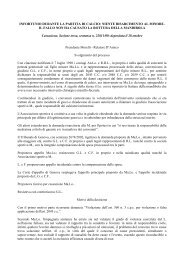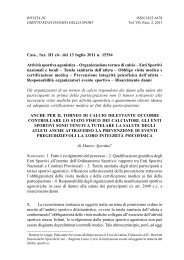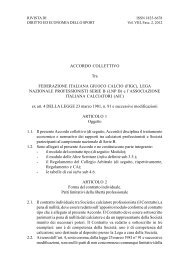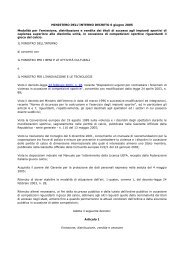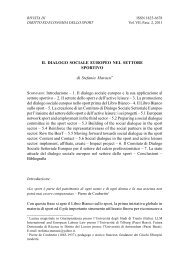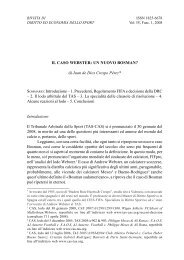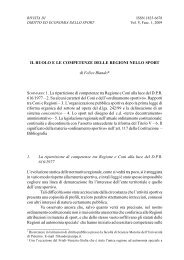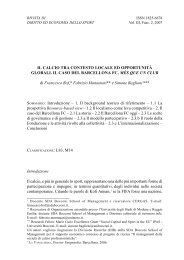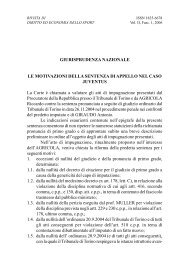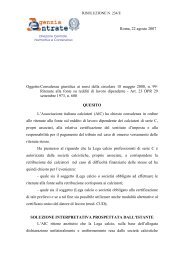Create successful ePaper yourself
Turn your PDF publications into a flip-book with our unique Google optimized e-Paper software.
14 Wladimir Andreff<br />
information and communication technologies – NICTs (from Internet to mobile<br />
phone and so on) through which images of sporting events can be instantly<br />
transm<strong>it</strong>ted at any moment to any place, throughout the globe.<br />
The result of all this has seen an increasing economic significance of sport<br />
measured by <strong>it</strong>s economic weight compared to GDP. In France for example, a<br />
macroeconomic aggregate, defined as the gross domestic sport expend<strong>it</strong>ure, is<br />
published. It sums up the amounts spent by residents and households in sporting<br />
goods and services w<strong>it</strong>h state government sport budget, sport expend<strong>it</strong>ures by local<br />
author<strong>it</strong>ies, sport sponsorship expenses, and TV broadcasting rights raised by sport<br />
event organizers. According to these data, the said aggregate has risen from 0.5%<br />
of GDP in 1971 to 1.77% in 2005, which means Euro 30.4 billion (the same ratio<br />
is between 1 and 2% in most developed countries). However, the relevant market<br />
for many firms involved in the sports economy is no longer a domestic market. It is<br />
defin<strong>it</strong>ely a global-wide market. Unfortunately, there is no accounting of the sports<br />
economy at a global level and national accounting of the sports economy is really<br />
developed only in a few developed market economies. Most of the economic data<br />
related to sports which are circulated by mass media are simply rough estimates.<br />
Therefore, the first concern for those economists interested in the sports economy<br />
should be to find ways through which data collection and data creation on all<br />
aspects of globalization in the sporting industry can be improved.<br />
Taking into account the aforesaid lim<strong>it</strong>ations on data collection, and desp<strong>it</strong>e<br />
these lim<strong>it</strong>s, a number of rough estimates on the global market for all sporting<br />
goods and services taken in 2004 was assessed being in the range of Euro 550-600<br />
billion. Global market for football is valued at Euro 250 billion. The market for all<br />
sporting goods is valued about Euro 150 billion. The value of broadcasting rights<br />
related to sport events is estimated at Euro 60 billion while the global market for<br />
sports sponsorship is nearly Euro 18 billion.<br />
In 2006, the global market for doping was assessed at Euro 6 billion.<br />
These figures must however be taken w<strong>it</strong>h a pinch of salt as <strong>it</strong> is crystal clear from<br />
the example hereunder. The widely known estimation of overall international trade<br />
(export) in sporting goods and equipment in the world is Dollari 2.5 billion in the<br />
year 2004. A recent study 1 covering 41 countries involved in this trade and making<br />
up for 96% of the overall sporting goods and equipment exported in the world has<br />
revealed that the real value could actually have been Dollari 28 billion in 2004, i.e<br />
ten times more. This latter figure is ne<strong>it</strong>her an estimate nor a rough figure. It is the<br />
result of a computation achieved w<strong>it</strong>h data available from the UN Comtrade data<br />
base. Two lessons must be derived from this example: first, even if media often<br />
tend to exaggerate their estimation of the global sports economy, their estimations<br />
are not always true;. Second, the study of global trade in sports goods is still in <strong>it</strong>s<br />
infancy and must be elaborated on in the future. Regarding the significance of<br />
foreign direct investment (henceforth FDI) by multinational companies (henceforth<br />
____________________<br />
1<br />
See M. AGLIETTA, W. ANDREFF, B. DRUT, Bourse et football, Rev. Econ. Pol., vol. 118, <strong>2008</strong>, 255-<br />
296.




